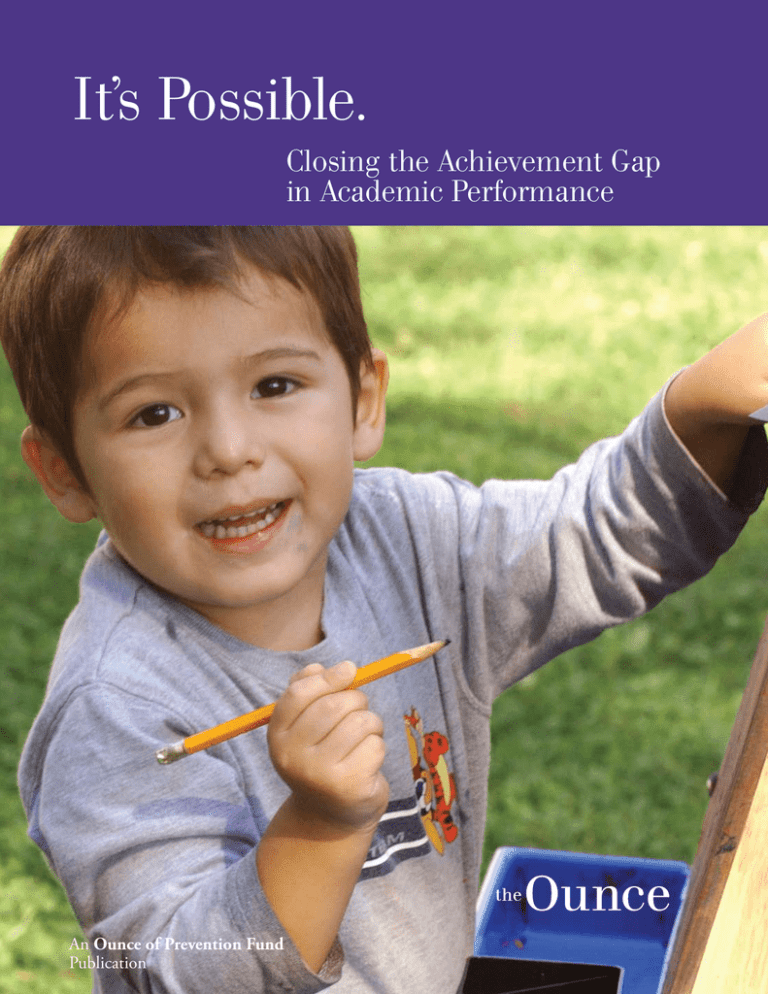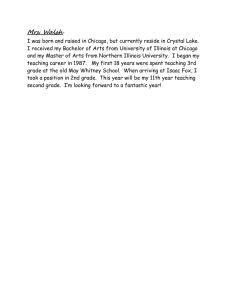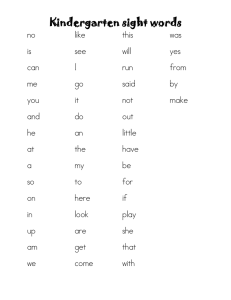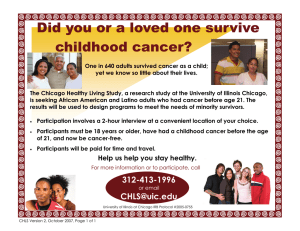Closing the Achievement Gap - The Ounce of Prevention Fund
advertisement

It’s Possible. Closing the Achievement Gap in Academic Performance An Ounce of Prevention Fund Publication It’s possible. We can close the achievement gap in academic performance between low-income children and their more advantaged peers by recognizing first and foremost that this gap is actually a gap in school-readiness skills — one that is rooted in experiences that take place long before a child enters kindergarten. Understand (the problem). The Achievement Gap: It’s Pervasive. Across the U.S., a persistent and widening gap in academic achievement exists between low-income students and their more advantaged peers. By age four, an 18-month gap is apparent between an impoverished child and his more affluent peers; that gap is still present at age 10 and continues throughout high school.1 Low-income students consistently to building our country’s human capital placed in special-education programs, underperform on school coursework and and maintaining our competitiveness in a labeled as having behavioral problems, on standardized tests, graduate high global economy. or held back one or more grade levels. to attend college. As a result, they are It’s Evident Before Kindergarten. Once established, gaps in school- ill-prepared to meet the challenges of Our nation’s public schools simply do readiness skills are difficult — and today’s workforce, which often forces not have the capacity or resources to more costly — to remedy, leading to them into low-skilled, low-paying jobs that remediate skills for the overwhelming pronounced gaps in achievement. A will not help them escape poverty. number of children who are not study of a 1998-99 kindergarten cohort academically or socially ready for school. found that the gaps in achievement The achievement gap is clearly one of Children who enter our K-12 public for children who entered kindergarten the most serious threats confronting school systems unprepared are often with lower mean achievement scores in the health of our nation’s economic and unable to take full advantage of what reading and math were wider still by the social systems today. Developing and the classroom has to offer. These are end of third grade.2 implementing effective programs and the children who struggle to keep up policies that narrow the gap are essential academically in class, who are frequently school at lower rates, and are less likely Ounce of Prevention Fund 1 The challenge is even greater for the homes scored in the lowest ranges on social skills to enter school with the growing number of young children from standardized tests measuring language confidence, motivation, persistence non-English-speaking homes. A Chicago skills. and curiosity that will prepare them 3 study of low-income children entering to be successful learners. In effect, public kindergarten found that twice as It’s Not Just Hard Skills. the achievement gap reflects a gap in many children from non-English-speaking Young children need both cognitive and school-readiness skills. Young children need both cognitive and social skills to enter school with the confidence, motivation, persistence and curiosity that will prepare them to be successful learners. 2 www.ounceofprevention.org By the Numbers Illinois has one of the most pronounced achievement gaps in the nation—only seven other states have a greater disparity in educational attainment.4 ¼-½ % 40 In Illinois, only 40% of Black males graduated high school with their 2005–06 class, compared to 82% of their White classmates.5 One-quarter to one-half of 18-to-24-year-olds in rural and inner-city areas of the state have no high school diploma, compared to 2% to 11% of those living in many Chicago suburbs and pockets of downstate Illinois.4 six The National Longitudinal Study of Youth shows that the gap in math skills between the lowest- and highest-income students is strikingly evident at age six.8 two-thirds less than An estimated two-thirds of public school fourth graders cannot read at grade level. More than 80% of Black and Latino fourth graders cannot read at grade level, compared with 58% of their White peers.7 In 2007, less than one-third of 11th grade Hispanic Chicago Public Schools students passed the state reading test, while more than twice that percentage of White students passed the test.6 6 out of 10 Six out of 10 fourth graders cannot do math at grade level. 85% of Black fourth graders cannot do math at grade level, compared to 78% of Latino children and about half of White children.7 Ounce of Prevention Fund Twice as likely 186,971 Children whose parents have not completed high school are twice as likely to be poor (48%) than are children of parents with a high school diploma (25%), while 3% of children with either parent holding a college degree are poor.10 In Illinois, 17% of children under age six live in families with incomes below the federal poverty level. This puts 186,971 of the state’s youngest citizens at risk for entering school unprepared to learn to their fullest abilities.9 3 The social and emotional skills (or so-called between children in low-income families common to living in poverty may not “soft” skills) a child acquires before age and high-income families begin to appear be able to adequately respond to their five — the capacity to control her behavior as early as 18 months. By age three, the babies’ needs, making it more difficult or impulses, the ability to get along with average child in a low-income household to forge the strong bonds required other children or seek out and accept knows fewer than half as many words as to help their babies thrive later in life. help — are just as important as academic a child in a high-income household. The overlay of poverty and this critical 12 skills in preparing her for school. Yet one- developmental phase means that our third of low-income children demonstrate It’s Exacerbated by Poverty. youngest children are most at risk during significant behavioral problems at transition Science tells us that the early experiences the period of the most substantial brain to kindergarten. and strong bonds babies develop with growth of their lives. 11 caring adults literally help build their Math skills at kindergarten entry — the brains. These earliest relationships shape Poor child care worsens the problem. ability to recognize numbers, problem brain development by helping young Studies show that only 30% of infant/ solve, use reasoning skills, and apply children learn to manage their behavior toddler care is adequate or better; a knowledge — are increasingly seen and emotions, which leads to the ability startling 10% is unacceptable.13 Early as an even better predictor of later to focus their attention on the tasks of Head Start, our nation’s best program academic success than early reading learning. for infants and toddlers living in poverty, reaches less than 3% of the eligible ability. Yet there is a significant gap in achievement in math performance For low-income children, the complex population.14 Our most vulnerable between low-income and higher-income process of healthy brain development children spend the years most critical children.8 is often compromised by the stress of to their brain development in the worst living in poverty. Parents struggling to environments. Early language and literacy development cope with severe financial instability, is a key component of school preparation, unsafe neighborhoods, lack of medical and differences in vocabulary growth care, hunger, and other stressors 4 www.ounceofprevention.org Science tells us that the early experiences and strong bonds babies develop with caring adults literally help build their brains. Ounce of Prevention Fund 5 Demonstrate (solutions). The Ounce of Prevention Fund Voluntary Doula and Home Visiting High-Quality Early Learning Programs In evidence-based home visiting programs, Quality center-based programs that are For more than two decades, the Ounce trained nurses and parent coaches provide grounded in research and best practices of Prevention Fund has been a leader in child-development and parenting information help at-risk children succeed in school. In developing, innovating and advancing to help teen parents create safe, stimulating such programs, well-trained professionals high-quality, birth-to-five programs. Our home environments; model positive and provide nurturing and continuous care programs are designed in response to language-rich relationships; and connect for infants, toddlers, and preschoolers; what research shows is holding back families to medical, dental, mental-health, build trusting relationships with parents; children — particularly low-income and other supports. emphasize language and literacy children — from realizing their potential development; support literacy activities in in school and beyond. By demonstrating Home visiting programs increase children’s the home; and provide access to family- how effective programs work, the Ounce literacy and high school graduation rates, support services. is in a unique position to improve the as well as how much parents read to lives of the children and families we their children. In addition, such programs Since opening in 2000, the Ounce’s serve directly in Illinois and to affect the increase positive birth outcomes for Educare Center in Chicago has set the education outcomes of countless children children, improve the likelihood that families standard for high-quality early care and at risk for school failure. have a medical home, and are credited with education, offering a full-day, full-year cutting child abuse in at-risk families by half. program that fosters school readiness in The cornerstones of our solutions are vulnerable children. The Educare model has voluntary home visiting and high-quality The Ounce’s groundbreaking doula inspired program, philanthropic and policy early learning programs. program pairs pregnant teen mothers with leaders to partner to create other Educare a trained mentor from the community who centers nationwide. These centers make guides the teen through late pregnancy, up the Bounce Learning Network of childbirth and into the early months of a Educare Centers. baby’s life. The Ounce funds and provides 6 technical assistance to home visiting Recent evaluations of five Educare Centers programs, and is the leading provider of in the Bounce Learning Network conducted professional development and training for by the Frank Porter Graham Child home visitors in the state. Development Institute at the University www.ounceofprevention.org Advocate (for what works). of North Carolina show promising early Early Interventions returns. Kindergarten-bound Educare Education policies and practices have graduates — particularly those who enter not kept pace with the scientific evidence the program at birth — approach national that shows a child begins learning at averages on measures of language and birth — not upon kindergarten entry. conceptual skills more than do most low- Investing in high-quality education income children. And children who began programs achieves both social and the Educare program between birth and economic gains. Longitudinal analyses two years old transition into kindergarten find that these programs positively affect with vocabularies and school-readiness children’s school achievement, reducing The Ounce has helped Illinois become a scores that meet or exceed national dropout rates and minimizing costs for national model for what effective early averages for all American children. remediation and special education. education systems should look like. We Significantly, our Educare Follow-up Study, Early education also reduces public and new public resources are targeted shows that the gains our students make outlays for crime services, job training to evidence-based models that promote persist into elementary school.15 In addition and joblessness. Leading economists early learning and improve parents’ to revealing the progress children are confirm that early investments in human capacities to serve as their children’s making during the critical early elementary capital represent the most effective first and most important teachers. school years, the study is giving us approach with the greatest return on invaluable insight into how early childhood public investment. are leading efforts to ensure that existing programs can better equip parents to help Guided by science and ongoing evaluation, we partner with community-based agencies their children transition to kindergarten; Early interventions for disadvantaged in Illinois and states across the country cope with stress; identify, and enroll children “raise the quality of the to strengthen their capacity to implement children in, high-quality elementary schools; workforce, enhance the productivity best practices. We are also mobilizing and become coaches and advocates for of schools and reduce crime, teenage advocates from the private, public and their children’s education. pregnancy, and welfare dependency. academic sectors whose voices are They raise earnings and promote social essential to shaping public policies that attachment. Focusing solely on earnings effectively prepare vulnerable children for gains, returns to dollars invested are as success in school and in life. high as 15–17 percent (per year).”16 Leading economists confirm that early investments in human capital represent the most effective approach with the greatest return on public investment. Ounce of Prevention Fund 7 Leverage (our impact). Private donations enable the Ounce to The Early Childhood Mental Health Project Home Visiting Study will inform program- develop and evaluate new program promotes age-appropriate social-emotional improvement efforts and contribute to best and policy initiatives, and advocate development and teachers’ capacity to practices throughout the field.15, 21 for public dollars that bring successful address developmental concerns. 19 Leveraging Our Impact programs to scale. Our new addition to Educare, the Family The Ounce is a particularly effective Knowledge and Innovation and Training Center, will house our “early advocate for young children and their By leveraging our knowledge and parent education” innovations so that families. By building a strong, non-partisan expertise, the Ounce is improving the parents can help their children sustain early cadre of champions, we are strategically quality of early childhood programs and education gains. pursuing efforts to align early childhood 20 services with the K-12 and higher creating positive early experiences for hundreds of thousands of babies, Evaluating Results education communities. Working together, toddlers, and preschoolers in Illinois Evaluating the impact of our programs is we can close the achievement gap and across the country. essential to help close the achievement and prepare all children to be more gap. Important longitudinal studies such capable, productive participants in a 21st as the Educare Follow-Up Study and century economy. Developing Innovative Approaches As a platform for program and policy change, Educare is where we are developing and implementing important initiatives to help close the achievement gap. Our Infant and Toddler Language and Literacy Promotion Project is allowing us to formalize strategies for better engaging parents and children around language and literacy development.17 Through our Early Math Initiative, we are training teachers and supporting parents in helping children build the math and problemsolving skills needed for school success.18 By leveraging our knowledge and expertise, the Ounce is improving the quality of early childhood programs and creating positive early experiences for hundreds of thousands of babies, toddlers, and preschoolers in Illinois and across the country. 8 www.ounceofprevention.org Sources and citations 1. Promoting Effective Early Learning: What Every Policymaker 11. Rimm-Kaufman, S.E., Pianta, R.C., and Cox, M.J. (2000). and Educator Should Know. (2007). New York, NY: National “Teachers’ Judgments of Problems in the Transition to Center for Children in Poverty. Kindergarten.” Early Childhood Research Quarterly, 15(2), 2. The Condition of Education 2004 (NCES 2004-077), Indicator 8. (2004). Washington, DC: U.S. Department of Education, National Center for Education Statistics. 3. The Chicago Program Evaluation Project: A Picture of Early Childhood Programs, Teachers, and Preschool-Age Children in Chicago. (2008). Princeton, NJ: Mathematica Policy Research, Inc. 4. Public Agenda for College and Career Success. (2008). Springfield, IL: Public Agenda Task Force and Illinois Board of Higher Education. 5. Given Half a Chance: The Schott 50 State Report on Public Education and Black Males, Executive Summary. (2008). Cambridge, MA: Schott Foundation for Public Education. 6. “School Report Card 2007: Achievement by Race and Income.” (Oct. 31, 2007). Chicago, IL: Chicago Sun-Times. 7. State of America’s Children 2008. (2008). Washington, DC: Children’s Defense Fund. 8. Heckman, J. (2008). “The Economic Case for Investing in 147-166. 12. Hart, B. and Risley, T.R. (1995). “Meaningful Differences in the Everyday Experiences of Young American Children.” Baltimore, MD: Brooks Publishing Co. 13. NICHD Study of Child Care and Youth Development. (2006). Washington, DC: National Institute of Child Health and Human Development. 14. The National Evaluation of Early Head Start: Early Head Start Works. (2005). Washington, DC: Zero to Three Policy Center. 15. Generously funded by the Alvin H. Baum Family Fund and the W. Clement & Jessie V. Stone Foundation. 16. Heckman, J. (2006). “Investing in Disadvantaged Young Children Is an Economically Efficient Policy.” Chicago, IL: University of Chicago Press. 17. Generously funded by the Louis R. Lurie Foundation, Polk Bros. Foundation, Chauncey and Marion Deering McCormick Foundation, Prince Charitable Trusts, and The Children’s Initiative – A Project of the J.B. and M.K. Pritzker Family Foundation. Disadvantaged Young Children.” Chicago, IL: University of 18. Generously funded in part by the Louis R. Lurie Foundation. Chicago Press. 19. Generously funded in part by The Blowitz-Ridgeway 9. Illinois Demographics of Young Poor Children. (2008). New York, NY: National Center for Children in Poverty. 10. Annual Social and Economic Supplement, America’s Families and Living Arrangements, Table C8, Current Population Survey. (2008). Washington, DC: U.S. Department of Commerce, Bureau of the Census. Foundation. 20. Generously funded in part by the Arie and Ida Crown Memorial Foundation, the Buffett Early Childhood Fund, and the Oscar G. & Elsa S. Mayer Family Foundation. 21. Planning grant generously sponsored by The Philanthropic Collaborative. The Ounce of Prevention Fund gives children in poverty the best chance for success in school and in life by advocating for and providing the highest quality care and education from birth to age five. Ounce of Prevention Fund 33 West Monroe Street, Suite 2400 Chicago, Illinois 60603 312.922.3863 www.ounceofprevention.org




